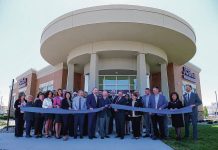An explosion of two demographic populations has driven the greater Columbus area’s overall growth for most of a decade and changed the makeup of the community, according to data released by the U.S. Census Bureau.
The latest American Community Survey, released in September, provides one-year data for the Columbus Metropolitan Statistical Area, which includes all of Bartholomew County. The census data includes subject matters such as population, household income, poverty rates and educational attainment.
From 2010 to 2017, the Columbus metro area increased by 5,185 people, or 6.7 percent. But with the white population dropping by 574, or nearly 1 percent, all of the metro area’s gains are coming from minority residents.
The biggest gains, in both population and percentage increase, are from black/African-American and Asian residents.
[sc:text-divider text-divider-title=”Story continues below gallery” ]
The black/African-American population grew by 2,699, which is more than a 270 percent increase — almost fourfold — from 2010 to 2017. The metro area’s Asian population grew by 3,081, an increase of nearly 106 percent — just slightly more than double — during this period.
Still growing, but at a more modest pace, is the area’s Hispanic/Latino population. It increased 661 people, or almost 13.7 percent, during the seven-year period.
What’s driving increases
Job opportunities and welcoming community efforts are primary reasons cited by local leaders for the growth of the black/African-American and Asian populations.
David Bosley, a retired Cummins engineer and member of the local African American Pastors Alliance, said he believes the black/African American population increase reflects what he and his wife Charlene have noticed.
“We have seen a lot of new faces here that we have not seen in any potential church congregation,” said Bosley, pastor of Dayspring Church of God Apostolic in Columbus. “I get the sense that (the population) is growing.”
He attributes some of the increase to outreach efforts in recruiting by Cummins, but not entirely.
“Some just say it’s the job, but by and large the people I speak to it’s not Cummins-related,” he said.
Seeing the type of growth in the black/African-American population the census data indicates is pleasing, Bosley said. He thinks the growth also is related to the efforts of the African American Pastors Alliance and the city of Columbus to make the community more welcoming.
The pastors alliance has worked to create dialogue and understanding between the black community and the mayor’s office, local law enforcement and the Bartholomew Consolidated School Corp., Bosley said.
“What we’re doing with the African American Pastors Alliance is we’re trying to establish relationships throughout the community,” Bosley said.
Creating such relationships will help head off any potential problems the African-American population might encounter, he said.
Tracy Souza, president and CEO of Heritage Fund — The Community Foundation of Bartholomew County, said she’s not surprised at the growth in the Asian, African-American and Latino populations.
“Our community has a robust economy and jobs attract people. Add to that the local employers — not just Cummins, but their size obviously impacts the numbers — wanting to find the very best talent and having a global marketplace to search for, that talent is going to bring in diversity. Talent comes in all kinds of packages,” she said.
Heritage Fund has led two Welcoming Community Surveys, in 2004 and 2011, to gauge the welcoming factor of the city as a place people want to live and work.
Results from the first two surveys led to the creation of some new community groups, such as the Columbus Young Professionals and the Columbus Area Multi-Ethnic Organization.
“What Welcoming Community was and is all about is creating a community that supports employers in their quest to bring talent and make the community part of the attraction,” Souza said.
“I know from my own kids that this generation looks at where they want to live, and not just the job. Employees want to live in a great community and one where they feel connected and part of the community,” she said.
Local NAACP President Stella Collins said she believes the local black/African-American population has increased, but questioned whether the size of increase indicated by the U.S. Census Bureau data was accurate.
“I definitely have seen (an increase) through the number of people coming to churches. A lot of African Americans go to church here,” she said.
Job opportunities in Columbus are attractive, as are the schools, Collins said.
“This is a diverse city that offers a lot and people see that. I believe people see the opportunity to come here and be successful,” Collins said.
”Visionary leadership”
Ghana native Stephen Aryee, 35, moved to Columbus in 2007 after graduating from DePauw University to begin working at Cummins. He served as co-leader of the Cummins African and African American Affinity Group, which has more than 200 members, from 2014 through earlier this year.
The 11-year city resident said he has come to appreciate the ongoing efforts to make Columbus attractive and welcoming, and the foundation set for that decades ago.
“The community’s visionary leadership beginning many years back with (J. Irwin Miller) created a very welcoming and vibrant global business community and mindset,” Aryee said. “This has brought over 22,000 manufacturing, technology and professional jobs to the community, a feat which is very unique for a town the size of Columbus.”
Aryee also noted that a simple thing such as the Blackwell Park soccer complex that has more than 30 fields is impressive for a city of Columbus’ size, and resonates with people from countries where soccer is the top sport.
Aryee said more work remains in the welcoming efforts, because some community members have had unwelcoming experiences, but largely the progress has been good.
“I am not just impressed by the remarkable foundation. I am also extremely impressed by the city’s continual work towards creating an environment for today and especially for future generations where people from diverse walks of life can thrive,” he said.
[sc:pullout-title pullout-title=”What is an MSA?” ][sc:pullout-text-begin]
A metropolitan statistical area (MSA) is an area with substantial population nucleus that has a high degree of economic and social integration with that core, according to the U.S. Census Bureau. The Columbus Metropolitan Statistical Area includes all of Bartholomew County.
[sc:pullout-text-end]




